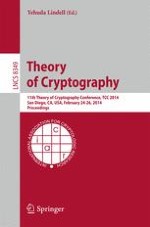2014 | OriginalPaper | Buchkapitel
Can Optimally-Fair Coin Tossing Be Based on One-Way Functions?
verfasst von : Dana Dachman-Soled, Mohammad Mahmoody, Tal Malkin
Erschienen in: Theory of Cryptography
Verlag: Springer Berlin Heidelberg
Aktivieren Sie unsere intelligente Suche, um passende Fachinhalte oder Patente zu finden.
Wählen Sie Textabschnitte aus um mit Künstlicher Intelligenz passenden Patente zu finden. powered by
Markieren Sie Textabschnitte, um KI-gestützt weitere passende Inhalte zu finden. powered by
Coin tossing is a basic cryptographic task that allows two distrustful parties to obtain an unbiased random bit in a way that neither party can bias the output by deviating from the protocol or halting the execution. Cleve [STOC’86] showed that in any
r
round coin tossing protocol one of the parties can bias the output by Ω(1/
r
) through a “fail-stop” attack; namely, they simply execute the protocol honestly and halt at some chosen point. In addition, relying on an earlier work of Blum [COMPCON’82], Cleve presented an
r
-round protocol based on one-way functions that was resilient to bias at most
$O(1/\sqrt r)$
. Cleve’s work left open whether ”‘optimally-fair’” coin tossing (i.e. achieving bias
O
(1/
r
) in
r
rounds) is possible. Recently Moran, Naor, and Segev [TCC’09] showed how to construct optimally-fair coin tossing based on oblivious transfer, however, it was left open to find the
minimal
assumptions necessary for optimally-fair coin tossing. The work of Dachman-Soled et al. [TCC’11] took a step toward answering this question by showing that any black-box construction of optimally-fair coin tossing based on a one-way functions with
n
-bit input and output needs Ω(
n
/log
n
) rounds.
In this work we take another step towards understanding the complexity of optimally-fair coin-tossing by showing that this task (with an arbitrary number of rounds) cannot be based on one-way functions in a black-box way, as long as the protocol is ”‘oblivious’” to the implementation of the one-way function. Namely, we consider a natural class of black-box constructions based on one-way functions, called
function oblivious
, in which the output of the protocol does not depend on the specific implementation of the one-way function and only depends on the randomness of the parties. Other than being a natural notion on its own, the known coin tossing protocols of Blum and Cleve (both based on one-way functions) are indeed function oblivious. Thus, we believe our lower bound for function-oblivious constructions is a meaningful step towards resolving the fundamental open question of the complexity of optimally-fair coin tossing.
